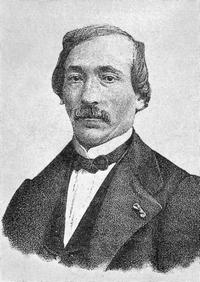Jean-Delphin Alard
Jean-Delphin Alard (8 March 1815 – 22 February 1888) was a French violinist, composer, and teacher. He was the son-in-law of Jean-Baptiste Vuillaume, and had Pablo de Sarasate amongst his students.
Jean-Delphin Alard | |
|---|---|
 | |
| Background information | |
| Born | 8 March 1815 Bayonne, France |
| Died | 22 February 1888 (age 72) Paris, France |
| Genres | Classical |
| Occupation(s) | Pedagogue, violinist |
| Instruments | Violin |
Biography
Alard was born in Bayonne, the son of an amateur violinist. From 1827 he was a pupil of F. A. Habeneck at the Paris Conservatoire, where he succeeded Pierre Baillot as professor in 1843, retaining the post till 1875.[1] He was also a pupil of François-Joseph Fétis.
His playing was full of fire and point, and his compositions had a great success in France, while his violin school had a wider vogue and considerably greater value. He was a representative of the modern French school of violin playing, composed nocturnes, duets, études, etc., for the violin, and was the author of an Ecole du violon, which was adopted by the Conservatoire. Mention should also be made of his edition in 40 parts of a selection of violin compositions by the most eminent masters of the 18th century, Les Maitres classiques du violon (Schott). Alard died in Paris.[1]
Notes
References

- This article incorporates text from a publication now in the public domain: Gilman, D. C.; Peck, H. T.; Colby, F. M., eds. (1905). New International Encyclopedia (1st ed.). New York: Dodd, Mead. Missing or empty
|title=(help)
External links
- Free scores by Jean-Delphin Alard at the International Music Score Library Project (IMSLP)
- Alard's Ten studies for violin with accompaniment of a second violin Op.10 Score from Sibley Music Library Digital Scores Collection